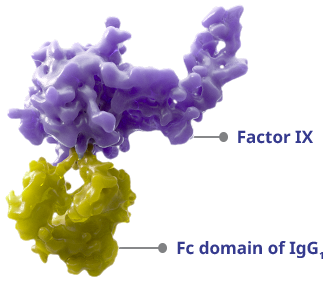ALPROLIX® is the only factor IX to utilize half-life extension with Fc Fusion technology
The natural recycling pathway of IgG1 allows ALPROLIX to stay in the body for an extended period of time between infusions1

- ALPROLIX is composed of rFIX covalently linked to the Fc region
of IgG11,2
– IgG1 is a naturally occurring protein with anti-inflammatory properties1,2
- ALPROLIX binds to the neonatal Fc receptor, which diverts ALPROLIX, delaying degradation and extending half-life1
ALPROLIX reaches its peak activity level as quickly as
BeneFIX® [coagulation factor IX (recombinant)]–within 10 minutes of
infusion3*†
Studies have not been conducted to assess the safety or efficacy of
ALPROLIX compared with BeneFIX.
*A subset of 22 patients (the sequential pharmacokinetic subgroup) received consecutive single IV doses of 50 IU/kg BeneFIX and ALPROLIX at the beginning of the B-LONG study (baseline) for direct comparison. For both ALPROLIX and BeneFIX, peak activity was reached approximately 10 minutes after the start of the infusion.3
†Peak activity level does not mean bleeds are resolved within 10 minutes.3
IgG1=immunoglobulin G1; rFIX=recombinant factor IX.
 WATCH NOW:
WATCH NOW: 
